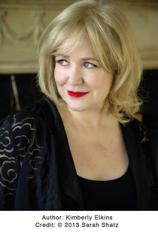What Is Visible
Review
What Is Visible
As I started reading Kimberly Elkins's debut novel, WHAT IS VISIBLE, I kept asking myself, "Why didn't I know this story before?" Much of the book takes place at the Perkins School for the Blind, which today is located just a mile or two from my house outside Boston. An acquaintance of mine lives in the Beacon Hill home once occupied by Perkins School founder Samuel Gridley Howe and his wife, "Battle Hymn of the Republic" author and poet Julia Ward Howe. And yet I had never heard of Dr. Howe's most notable protégé, Laura Bridgman, whoin the mid-19th century, was one of the most famous women in the world, but whose story about being the first deaf and blind person to learn language has since been subsumed by the story of Helen Keller, who came 50 years after her.
"Laura's voice, in particular, is lively and engaging, full of pent-up energy and longing. Around her, those charged with her upbringing and well-being encounter dramas and scandals of their own."
As Elkins explains in her afterword, in fictionalizing the story of Laura Bridgman, she adhered to the writer Thomas Mallon's dictate to write historical fiction on the basis of "what might have happened as well." So the fundamentals of Laura’s story remain intact in Elkins's well-researched novel. Laura, who lost not only her hearing and sight but also her senses of smell and taste following a bout of scarlet fever when she was a toddler, was sent from her home in Hanover, New Hampshire, to the Perkins School in Boston when she was still a young girl.
There, she was made something of a star pupil of Samuel Gridley Howe, who used a variety of methods to enable Laura to communicate using tactile sign language as well as reading raised lettering (Braille was not yet used in the United States at that time) and writing. Laura became quite a celebrity; she was featured in a chapter in Charles Dickens's AMERICAN NOTES (the author made a point of meeting her when he was on one of his American tours) and commemorated in dolls sold around the country.
Laura, who had been taken from her own family at such a young age, saw Howe as a father figure. When he began shifting his focus to his own family following his marriage to Julia Ward (who was apparently quite uneasy around the disabled children with whom her husband worked) and their subsequent parenthood, Laura suffered as a result. She longed to find meaning through reading the Bible, but Howe and his fellow progressive educators were determined to use her as an example of how moral education can be imparted without relying on traditional religious education. Laura had quite a mind of her own, thanks in no small part to Howe's work with her, and she became determined to take her education and her life into her own hands.
Told in alternating chapters through the voices of Laura, Howe, his wife Julia, and Laura's beloved teacher Sarah, as well as through letters, WHAT IS VISIBLE traces Laura's life from a teenager in the 1840s through her meeting with a young Helen Keller in the 1880s. Laura's voice, in particular, is lively and engaging, full of pent-up energy and longing. Around her, those charged with her upbringing and well-being encounter dramas and scandals of their own.
Many readers of WHAT IS VISIBLE will be curious to know which elements of these stories are taken from the historical record and which are embellished or invented by the novelist. Elkins's excellent afterword spells this out, and those who, like myself, find themselves wanting to know even more about this nearly forgotten figure can find out much more by picking up the biographies that Elkins cites as her inspiration for giving Laura Bridgman a new voice --- and renewed visibility.
Reviewed by Norah Piehl on July 25, 2014
What Is Visible
- Publication Date: June 16, 2015
- Genres: Fiction, Historical Fiction
- Paperback: 336 pages
- Publisher: Twelve
- ISBN-10: 1455528951
- ISBN-13: 9781455528950





